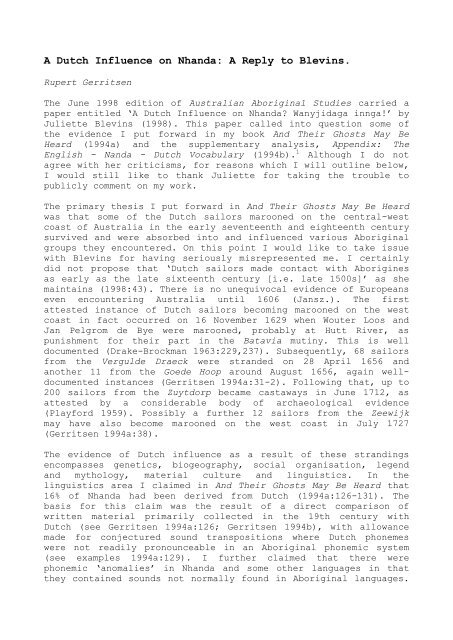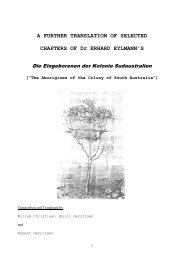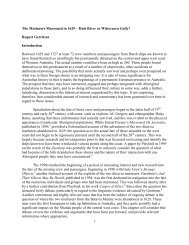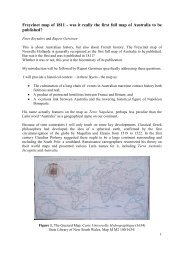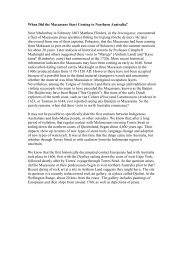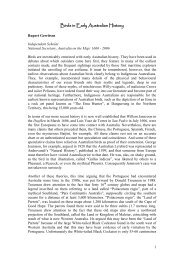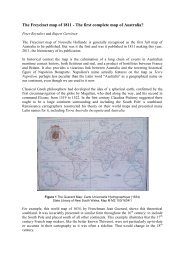A Dutch Influence on Nhanda - Rupert Gerritsen Research and ...
A Dutch Influence on Nhanda - Rupert Gerritsen Research and ...
A Dutch Influence on Nhanda - Rupert Gerritsen Research and ...
Create successful ePaper yourself
Turn your PDF publications into a flip-book with our unique Google optimized e-Paper software.
A <str<strong>on</strong>g>Dutch</str<strong>on</strong>g> <str<strong>on</strong>g>Influence</str<strong>on</strong>g> <strong>on</strong> <strong>Nh<strong>and</strong>a</strong>: A Reply to Blevins.<br />
<strong>Rupert</strong> <strong>Gerritsen</strong><br />
The June 1998 editi<strong>on</strong> of Australian Aboriginal Studies carried a<br />
paper entitled ‘A <str<strong>on</strong>g>Dutch</str<strong>on</strong>g> <str<strong>on</strong>g>Influence</str<strong>on</strong>g> <strong>on</strong> <strong>Nh<strong>and</strong>a</strong> Wanyjidaga innga!’ by<br />
Juliette Blevins (1998). This paper called into questi<strong>on</strong> some of<br />
the evidence I put forward in my book And Their Ghosts May Be<br />
Heard (1994a) <strong>and</strong> the supplementary analysis, Appendix: The<br />
English - N<strong>and</strong>a - <str<strong>on</strong>g>Dutch</str<strong>on</strong>g> Vocabulary (1994b). 1 Although I do not<br />
agree with her criticisms, for reas<strong>on</strong>s which I will outline below,<br />
I would still like to thank Juliette for taking the trouble to<br />
publicly comment <strong>on</strong> my work.<br />
The primary thesis I put forward in And Their Ghosts May Be Heard<br />
was that some of the <str<strong>on</strong>g>Dutch</str<strong>on</strong>g> sailors maro<strong>on</strong>ed <strong>on</strong> the central-west<br />
coast of Australia in the early seventeenth <strong>and</strong> eighteenth century<br />
survived <strong>and</strong> were absorbed into <strong>and</strong> influenced various Aboriginal<br />
groups they encountered. On this point I would like to take issue<br />
with Blevins for having seriously misrepresented me. I certainly<br />
did not propose that ‘<str<strong>on</strong>g>Dutch</str<strong>on</strong>g> sailors made c<strong>on</strong>tact with Aborigines<br />
as early as the late sixteenth century [i.e. late 1500s]’ as she<br />
maintains (1998:43). There is no unequivocal evidence of Europeans<br />
even encountering Australia until 1606 (Jansz.). The first<br />
attested instance of <str<strong>on</strong>g>Dutch</str<strong>on</strong>g> sailors becoming maro<strong>on</strong>ed <strong>on</strong> the west<br />
coast in fact occurred <strong>on</strong> 16 November 1629 when Wouter Loos <strong>and</strong><br />
Jan Pelgrom de Bye were maro<strong>on</strong>ed, probably at Hutt River, as<br />
punishment for their part in the Batavia mutiny. This is well<br />
documented (Drake-Brockman 1963:229,237). Subsequently, 68 sailors<br />
from the Vergulde Draeck were str<strong>and</strong>ed <strong>on</strong> 28 April 1656 <strong>and</strong><br />
another 11 from the Goede Hoop around August 1656, again welldocumented<br />
instances (<strong>Gerritsen</strong> 1994a:31-2). Following that, up to<br />
200 sailors from the Zuytdorp became castaways in June 1712, as<br />
attested by a c<strong>on</strong>siderable body of archaeological evidence<br />
(Playford 1959). Possibly a further 12 sailors from the Zeewijk<br />
may have also become maro<strong>on</strong>ed <strong>on</strong> the west coast in July 1727<br />
(<strong>Gerritsen</strong> 1994a:38).<br />
The evidence of <str<strong>on</strong>g>Dutch</str<strong>on</strong>g> influence as a result of these str<strong>and</strong>ings<br />
encompasses genetics, biogeography, social organisati<strong>on</strong>, legend<br />
<strong>and</strong> mythology, material culture <strong>and</strong> linguistics. In the<br />
linguistics area I claimed in And Their Ghosts May Be Heard that<br />
16% of <strong>Nh<strong>and</strong>a</strong> had been derived from <str<strong>on</strong>g>Dutch</str<strong>on</strong>g> (1994a:126-131). The<br />
basis for this claim was the result of a direct comparis<strong>on</strong> of<br />
written material primarily collected in the 19th century with<br />
<str<strong>on</strong>g>Dutch</str<strong>on</strong>g> (see <strong>Gerritsen</strong> 1994a:126; <strong>Gerritsen</strong> 1994b), with allowance<br />
made for c<strong>on</strong>jectured sound transpositi<strong>on</strong>s where <str<strong>on</strong>g>Dutch</str<strong>on</strong>g> ph<strong>on</strong>emes<br />
were not readily pr<strong>on</strong>ounceable in an Aboriginal ph<strong>on</strong>emic system<br />
(see examples 1994a:129). I further claimed that there were<br />
ph<strong>on</strong>emic ‘anomalies’ in <strong>Nh<strong>and</strong>a</strong> <strong>and</strong> some other languages in that<br />
they c<strong>on</strong>tained sounds not normally found in Aboriginal languages.
It is in these areas that Blevins has challenged my evidence. As<br />
she correctly notes there are differences between material she has<br />
recorded <strong>and</strong> the written historical materials that I relied up<strong>on</strong>.<br />
I d<strong>on</strong>'t dispute that some differences exist. What is at issue is<br />
the reas<strong>on</strong> for these differences. Her assumpti<strong>on</strong> that the material<br />
she has recorded exactly corresp<strong>on</strong>ds with the earliest historical<br />
materials is an unwarranted <strong>on</strong>e, in effect treating this<br />
Aboriginal language as a linguistic fossil when there is<br />
c<strong>on</strong>siderable evidence of massive change in Aboriginal languages<br />
having taken place since the commencement of British col<strong>on</strong>isati<strong>on</strong>.<br />
One need <strong>on</strong>ly c<strong>on</strong>sider the positi<strong>on</strong> of the Nyungar languages in<br />
the south west of Western Australia to appreciate the significance<br />
of this point. These languages, in the c<strong>on</strong>text of massive social<br />
<strong>and</strong> cultural ‘disturbance’, <strong>and</strong> subject to a major foreign<br />
language influence (English), have evolved into Neo-Nyungar with<br />
c<strong>on</strong>sequent changes in vocabulary, grammar <strong>and</strong> ph<strong>on</strong>ology (Douglas<br />
1976:3; Dench 1994:175). By analogy <strong>on</strong>e would expect a similar<br />
effect to have taken place in Kardu languages such as <strong>Nh<strong>and</strong>a</strong> where<br />
similar events have taken place over the last 140 years. Certainly<br />
the historical evidence points to factors that may have had<br />
c<strong>on</strong>siderable impact <strong>on</strong> <strong>Nh<strong>and</strong>a</strong>. By 1879 the Government Resident<br />
George Eliot (1879:4) reported that "I do not believe there are a<br />
dozen [<strong>Nh<strong>and</strong>a</strong>] within twenty miles of Geraldt<strong>on</strong>". Following this<br />
enormous depopulati<strong>on</strong> there was a movement of peoples from the<br />
east where different languages were spoken (Bates 1938:106; 1985:<br />
58,62-3; Tindale 1974:102,254,260). Even where informant's<br />
antecedents can be clearly established there is still the problem<br />
of unc<strong>on</strong>scious absorpti<strong>on</strong> of other languages, an effect noted<br />
elsewhere by Dix<strong>on</strong> (1981:14-5; 1983:437) <strong>and</strong> others (Breen<br />
1981:281; Morphy 1983:5). Because of these sorts of difficulties,<br />
the lack of published material <strong>on</strong> the languages I was interested<br />
in at the time (principally in the Kardu sub-group), <strong>and</strong> the fact<br />
that historical materials were closer in time to the maro<strong>on</strong>ing of<br />
<str<strong>on</strong>g>Dutch</str<strong>on</strong>g> sailors than modern materials I deliberately chose to rely<br />
<strong>on</strong> historical materials in my research. I was well aware that<br />
historical materials have their own problems, such as which<br />
language they apply to <strong>and</strong> the issue of transcripti<strong>on</strong> errors, <strong>and</strong><br />
discuss this in my book (1994a:124,212-20,303n38,323n22,n24,n31).<br />
I endeavoured to eliminate, with the materials then available, any<br />
obvious transcripti<strong>on</strong> errors.<br />
Looking at some of the specific instances Blevins raises I noted<br />
that she makes asserti<strong>on</strong>s such as ‘<strong>Nh<strong>and</strong>a</strong> has no c<strong>on</strong>s<strong>on</strong>ant<br />
combinati<strong>on</strong>s of k+n.’ (1998:44), equating this with the nasal<br />
velar 'ng'. In doing so she ignores the evidence that I have<br />
already put forward showing that this is not the case (1994a:213,<br />
303). Having made an intensive study of transcripti<strong>on</strong> errors, with<br />
particular reference to word-initial 'kn' <strong>and</strong> 'gn' (to be<br />
published in the near future) I believe Blevins has been too hasty<br />
in her judgements. My initial propositi<strong>on</strong> was that the appearance<br />
of 'kn' in a number of historical word lists in WA was the result
of a <str<strong>on</strong>g>Dutch</str<strong>on</strong>g> influence, such a c<strong>on</strong>s<strong>on</strong>ant combinati<strong>on</strong> being a<br />
characteristic of <str<strong>on</strong>g>Dutch</str<strong>on</strong>g> ph<strong>on</strong>ology. The argument was <strong>on</strong>e of simple<br />
coincidence. Its appearance in historical vocabularies in other<br />
parts of Australia was puzzling but perhaps explicable as a poor<br />
transcripti<strong>on</strong> of the pre-stopped velar 'kng' such as is still<br />
found in Eastern Arrente. Nevertheless a good illustrati<strong>on</strong> of the<br />
apparent historical reality of a ph<strong>on</strong>eme akin to 'kn' in WA can be<br />
found in Wajuk, originally spoken in the Perth area. This would<br />
appear shows that it is highly improbable that the 'kn' was a<br />
mistranscribed 'ng' as Blevins asserts. In vocabularies compiled<br />
by Ly<strong>on</strong> (1833), Moore in 1838-9 (1884) <strong>and</strong> Knight (1886) numerous<br />
words beginning with "Ng..." can be found. Both Ly<strong>on</strong> (6/4/1833:56)<br />
<strong>and</strong> Moore (1884:vi-vii) explicitly recognise the nasal velar, each<br />
describing the sound in exactly the same terms as Blevins, as in<br />
'sing' <strong>and</strong> 'ring'. Yet each of these three authors also record <strong>on</strong>e<br />
or two examples of words with initial 'kn': knoobar [Area name]<br />
(Ly<strong>on</strong> 20/4/1833:64); knude, k-nude [A species of casuarina] (Moore<br />
1884:42,92) <strong>and</strong> knolga [teeth], knangar [beard] (Knight 1886:333).<br />
Blevins does not proffer any other evidence to bolster her claim<br />
that 'kn' was a mistranscribed 'ng' apart from the apparent<br />
discrepancy between the modern material she collected <strong>and</strong> the<br />
historical material. I put forward additi<strong>on</strong>al evidence in Ghosts<br />
(1994a:213-4) indicating the reality of a ph<strong>on</strong>eme akin to 'kn' in<br />
historical transcripti<strong>on</strong>s. I have since developed a number of<br />
other arguments <strong>and</strong> lines of evidence supporting this c<strong>on</strong>tenti<strong>on</strong><br />
<strong>and</strong> these will be discussed in detail in the forthcoming paper.<br />
I have also been taken to task with my spelling of <strong>Nh<strong>and</strong>a</strong> as<br />
‘N<strong>and</strong>a’ by Blevins (44). This usage was not a c<strong>on</strong>sequence of my<br />
alleged ignorance, as Blevins implies, but was adopted because it<br />
was a form comm<strong>on</strong> in many linguistic works up until recent times<br />
(see for example Capell 1963:W30; Oates <strong>and</strong> Oates 1970:58; Wurm<br />
1972:50,126; Tindale 1974:249; Blake 1991:133). As the c<strong>on</strong>venti<strong>on</strong><br />
appears to have changed I use <strong>Nh<strong>and</strong>a</strong> here, noting, however, that<br />
other authorities use Nhanta as well (Thieberger 1987:53;<br />
1993:90). C<strong>on</strong>sequently Blevins' argument, which flows from my<br />
apparent ‘mistake’, is ill-founded <strong>and</strong> her dispute is not with me<br />
but with the linguist c<strong>on</strong>venti<strong>on</strong> adopted by various authorities.<br />
Regarding the fricative sounds s, sh, f, z <strong>and</strong> h, another area of<br />
disputati<strong>on</strong>, Blevins correctly notes that ‘very few Australian<br />
languages have fricative ph<strong>on</strong>emes’ (1998:44). From there she<br />
builds an argument based <strong>on</strong> the claim that I ‘do not present a<br />
single etymology where a <str<strong>on</strong>g>Dutch</str<strong>on</strong>g> s, sh, or f actually occurs in a<br />
purportedly borrowed <strong>Nh<strong>and</strong>a</strong> word’ (1998:44). Firstly, to set the<br />
record straight, I never identified any <strong>Nh<strong>and</strong>a</strong> word as c<strong>on</strong>taining<br />
sh. Apart from that there were six words identified c<strong>on</strong>taining s<br />
or f, but four of these were place names lacking any etymology.<br />
C<strong>on</strong>sequently <strong>on</strong>e would simply be guessing if you tried to arrive<br />
at a <str<strong>on</strong>g>Dutch</str<strong>on</strong>g> derived etymology for them. With <strong>on</strong>e of the remaining<br />
examples, mesja [here] I did suggest a possible etymology moesje
[spot] but did not think this was c<strong>on</strong>clusive. I was unable to find<br />
a credible etymology for the other remaining example taafda [knee]<br />
though I suspect it may have been slang or some other idiomatic<br />
expressi<strong>on</strong> which will eventually come to light.<br />
Blevins c<strong>on</strong>jectures that the occurrence of these fricatives may<br />
have resulted from transcripti<strong>on</strong> errors, citing an instance where<br />
the h<strong>and</strong>writing of "<strong>on</strong>e explorer, Goldsworthy ...'Ijjecka' could<br />
easily have been misinterpreted as 'Isseka' "(1998:44).<br />
Unfortunately the facts are, firstly, that Goldsworthy was not an<br />
explorer but the Col<strong>on</strong>ial Secretary for Western Australia<br />
(Goldsworthy 1886:314); sec<strong>on</strong>dly, the material published under his<br />
name was probably not obtained by him but by a local civil<br />
servant; <strong>and</strong> finally, he was not my source for this word anyway!<br />
It is a pre-existing place name. That of course does not eliminate<br />
a transcripti<strong>on</strong> error somewhere al<strong>on</strong>g the line, a possibility of<br />
which I was quite well aware. However I c<strong>on</strong>sidered that this was<br />
unlikely because of the occurrence of ‘Isachar Well’ in the same<br />
area, a point I made in Ghosts (1994a:124) <strong>and</strong> which Blevins seems<br />
to have been ignored. 2<br />
Regarding the occurrence of z in historical transcripti<strong>on</strong>s,<br />
Blevins claims that I give <strong>on</strong>ly <strong>on</strong>e example. Again this is not<br />
correct, I gave three examples (1994a:124) - wezueda [possum],<br />
Waardamarza [Pers<strong>on</strong>al name], Oolinzurra [Place name]. Blevins<br />
could be right that the correct transcripti<strong>on</strong> of wezueda is<br />
wayurda, but, as she acknowledges due to "ph<strong>on</strong>etic variati<strong>on</strong> ...<br />
wayurda is sometimes pr<strong>on</strong>ounced with a medial 'zs' sound, but this<br />
is just a variant of the 'y' sound ..." (1998:44-5)[My emphasis].<br />
Given this admissi<strong>on</strong> I hardly see how the occurrence of z in this<br />
instance can be treated as a transcripti<strong>on</strong> error; an<br />
unc<strong>on</strong>venti<strong>on</strong>al or variable transcripti<strong>on</strong>, perhaps, but not a<br />
transcripti<strong>on</strong> error. Furthermore this raises the questi<strong>on</strong> of<br />
whether this explanati<strong>on</strong> is valid for the other examples Blevins<br />
overlooked. And if this ph<strong>on</strong>ological feature is ‘widespread<br />
throughout Australia’ (1998:45), <strong>and</strong> my examples just<br />
mistranscripti<strong>on</strong>s, as Blevins claims, why is it so extremely rare<br />
in other historical vocabularies<br />
The glottal stop 'h' is another c<strong>on</strong>tested ph<strong>on</strong>eme. Likened by<br />
Blevins to "exclamati<strong>on</strong>s like 'uh-uh'" (1998:43) as in uthu [dog],<br />
she err<strong>on</strong>eously claims I <strong>on</strong>ly provide ‘a single example’<br />
(1998:45). In fact I provided four examples in my book (1994a:125)<br />
- hot.ther [dog], hewerloo [light], howa [water] <strong>and</strong> hurder<br />
[today] - <strong>and</strong> a further three in the Appendix (1994b). One might<br />
be forgiven for thinking Blevins is splitting hairs here with her<br />
point <strong>on</strong> the technical descripti<strong>on</strong> of the glottal stop. But the<br />
real point is how did this feature, <strong>on</strong>e of a number in <strong>Nh<strong>and</strong>a</strong><br />
that, as Blevins notes, ‘makes it very different from other<br />
Australian languages of the area’ (1998:43), come to be in the<br />
language
I would propose that the ‘glottal stop’ was the form the <str<strong>on</strong>g>Dutch</str<strong>on</strong>g> 'h'<br />
took when incorporated in the local Aboriginal ph<strong>on</strong>ological<br />
system, recorded back as 'h' by English speakers whose<br />
ph<strong>on</strong>ological system has str<strong>on</strong>g similarities to the <str<strong>on</strong>g>Dutch</str<strong>on</strong>g> <strong>on</strong>e. A<br />
number of the words in historical <strong>Nh<strong>and</strong>a</strong> c<strong>on</strong>taining 'h' appear to<br />
have <str<strong>on</strong>g>Dutch</str<strong>on</strong>g> derivati<strong>on</strong> (1994b). A further illustrative example,<br />
this time from Malgana, the language formerly spoken around Shark<br />
Bay immediately to the north (<strong>and</strong> <strong>on</strong>ly 60 km from the Zuytdorp<br />
wrecksite), is the word for 'shark', hee<strong>on</strong> [Hooley 1865] - in<br />
<str<strong>on</strong>g>Dutch</str<strong>on</strong>g> 'sharks' is haaien. Just coincidence perhaps<br />
My overall c<strong>on</strong>clusi<strong>on</strong> that 16% of <strong>Nh<strong>and</strong>a</strong> was derived from <str<strong>on</strong>g>Dutch</str<strong>on</strong>g><br />
has also been challenged by Blevins, firstly by making the<br />
surprising claim that ‘n<strong>on</strong>e of the evidence is given in the book<br />
itself’ (1998:46). This appears to ignore the extensive arguments,<br />
evidence <strong>and</strong> examples I put forward <strong>on</strong> pages 126-132 <strong>and</strong><br />
elsewhere. To support her argument she points to a couple of<br />
supposedly err<strong>on</strong>eous examples from the Appendix. Unfortunately I<br />
didn't claim the terms she refers to as <str<strong>on</strong>g>Dutch</str<strong>on</strong>g> derived items. In<br />
the case of 'Me' [ngai, ni] I listed a possible derivati<strong>on</strong> [mij]<br />
but did not include it in the final count because I did not<br />
c<strong>on</strong>sider it a valid example. Similarly, although I listed the<br />
<str<strong>on</strong>g>Dutch</str<strong>on</strong>g> word for ant [mier] al<strong>on</strong>gside the <strong>Nh<strong>and</strong>a</strong> equivalent [minga]<br />
I did not c<strong>on</strong>sider there was a valid c<strong>on</strong>necti<strong>on</strong> between them for<br />
the very reas<strong>on</strong> Blevins gives, it is a comm<strong>on</strong> term in most of the<br />
regi<strong>on</strong>, <strong>and</strong> also because it appeared to me that there was little<br />
similarity between the two words. Blevins makes the further claim<br />
that I did ‘not provide a set of regular (or irregular) sound<br />
changes to derive the <strong>Nh<strong>and</strong>a</strong> words from the proposed <str<strong>on</strong>g>Dutch</str<strong>on</strong>g> source<br />
forms’ (1998:46). Inexplicably Blevins again appears to overlook<br />
the evidence <strong>and</strong> arguments of sound changes I put forward in the<br />
book (1994a:128-30) <strong>and</strong> in the Appendix (1994b:2-3).<br />
Finally Blevins discounts my analysis ‘because nearly all the<br />
words ... have related forms in Aboriginal languages in other<br />
parts of Australia’ (1998:46). I readily acknowledge that the bulk<br />
of <strong>Nh<strong>and</strong>a</strong> bears some relati<strong>on</strong>ship to other Australian languages.<br />
Similarly I am sure there are competing etymologies for some of<br />
the words I would claim to have <str<strong>on</strong>g>Dutch</str<strong>on</strong>g> derivati<strong>on</strong>. In time it may<br />
well be shown that some of these derivati<strong>on</strong>s have greater validity<br />
than mine. Nevertheless I would still insist that part of <strong>Nh<strong>and</strong>a</strong><br />
is of <str<strong>on</strong>g>Dutch</str<strong>on</strong>g> derivati<strong>on</strong> <strong>and</strong> that no credible Australian etymology<br />
will be found for many of the words I have identified as being of<br />
<str<strong>on</strong>g>Dutch</str<strong>on</strong>g> derivati<strong>on</strong>. C<strong>on</strong>versely Blevins asserti<strong>on</strong> that, ‘it is<br />
possible to show that most <strong>Nh<strong>and</strong>a</strong> words originate from a motherlanguage<br />
(called Proto-Pama-Nyungan) ... spoken <strong>on</strong> the Australian<br />
c<strong>on</strong>tinent between 3,000 <strong>and</strong> 5,000 years ago (1998:43), is highly<br />
questi<strong>on</strong>able. The methodological validity of linguistic<br />
rec<strong>on</strong>structi<strong>on</strong> with such time depth <strong>and</strong> lacking any means of
verificati<strong>on</strong> is extremely dubious, as recently pointed out by<br />
Dix<strong>on</strong> (1997).<br />
In c<strong>on</strong>cluding I would like to again draw attenti<strong>on</strong> to comparable<br />
circumstances in Cape York <strong>and</strong> Arnhem L<strong>and</strong>. In both these cases<br />
Aboriginal peoples came into c<strong>on</strong>tact with outside influences,<br />
Papuans in Cape York <strong>and</strong> Macassans in Arnhem L<strong>and</strong>. These c<strong>on</strong>tacts<br />
resulted in the absorpti<strong>on</strong> of "foreign" sounds, the fricatives s<br />
<strong>and</strong> z in Cape York for example (Capell 1970:240; Wurm 1972:52),<br />
<strong>and</strong> the appearance of Macassan loan words in Arnhem L<strong>and</strong> (McKnight<br />
1972:295-304). Is it then so surprising that unusual linguistic<br />
features would appear <strong>on</strong> the west coast of Australia in areas<br />
where we know <str<strong>on</strong>g>Dutch</str<strong>on</strong>g> sailors were maro<strong>on</strong>ed in the 17th <strong>and</strong> early<br />
18th centuries. I think not.<br />
NOTES<br />
1<br />
This document was excluded from the book for cost reas<strong>on</strong>s <strong>and</strong> was previously<br />
<strong>on</strong>ly available up<strong>on</strong> applicati<strong>on</strong> to the publisher, Fremantle Arts Centre Press.<br />
Because of the interest that has been aroused, copies have now been lodged in<br />
the Battye <strong>and</strong> Nati<strong>on</strong>al Libraries to make it more accessible.<br />
2<br />
"Isachar Well" was first recorded in 1869 by Surveyor W. Phelps. Geologist<br />
H.Y.G. Brown recorded "Isacca Well" in 1872. "Isseka" first appears in records<br />
in 1912 as "Isseka Progress Associati<strong>on</strong>" (WA Department of L<strong>and</strong> Administrati<strong>on</strong>:<br />
Geographic Names File N/C 711/64)<br />
REFERENCES<br />
Bates, D. M. 1938 The Passing of the Aborigines, John Murray,<br />
L<strong>on</strong>d<strong>on</strong>.<br />
1985 The Native Tribes of Western Australia, I. White (ed),<br />
Nati<strong>on</strong>al Library of Australia, Canberra.<br />
Blake, B. J. 1991 Australian Aboriginal Languages, University of<br />
Queensl<strong>and</strong> Press, Brisbane.<br />
Blevins, J. 1998 A <str<strong>on</strong>g>Dutch</str<strong>on</strong>g> <str<strong>on</strong>g>Influence</str<strong>on</strong>g> <strong>on</strong> <strong>Nh<strong>and</strong>a</strong> Wanyjidaga innga!<br />
Australian Aboriginal Studies 1,43-46.<br />
Breen, J. G. 1981 Margany <strong>and</strong> Gunya. In R. M. W. Dix<strong>on</strong> <strong>and</strong> B. J.<br />
Blake (eds), H<strong>and</strong>book of Australian Languages, vol. 2,<br />
Australian Nati<strong>on</strong>al University Press, Canberra.<br />
Capell, A. 1963 Linguistic Survey of Australia, Australian<br />
Institute of Aboriginal Studies, Sydney.<br />
1970 Linguistic change in Australia. In A. R. Piling <strong>and</strong> R.<br />
A. Piling (eds), Diprotod<strong>on</strong> to Detribalisati<strong>on</strong>, Michigan<br />
State University Press, East Lansing.<br />
Dench, A. 1994 Nyungar. In N. Thieberger <strong>and</strong> W. McGregor (eds),<br />
Macquarie Aboriginal Words, Macquarie Library, Macquarie<br />
University.<br />
Dix<strong>on</strong>, R. M. W. 1981 Wargamay. In. R. M. W. Dix<strong>on</strong> <strong>and</strong> B. J. Blake<br />
(eds), H<strong>and</strong>book of Australian Languages, vol. 2, Australian<br />
Nati<strong>on</strong>al University Press, Canberra.
1983 Nyawaygi. In. R. M. W. Dix<strong>on</strong> <strong>and</strong> B. J. Blake (eds),<br />
H<strong>and</strong>book of Australian Languages, vol. 3, John Benjamins,<br />
Amsterdam.<br />
1997 The Rise <strong>and</strong> Fall of Languages, Cambridge University<br />
Press, Cambridge.<br />
Douglas, W. H. 1976 The Aboriginal Languages of South-Western<br />
Australia, 2nd edn., Australian Institute of Aboriginal<br />
Studies, Canberra.<br />
Drake-Brockman, H. 1963 Voyage to Disaster, Angus <strong>and</strong> Roberts<strong>on</strong>,<br />
Sydney.<br />
Eliot, G. 1879 In C. G. Nicolay (Comp.), Notes <strong>on</strong> the Aborigines<br />
of Western Australia for the Col<strong>on</strong>ial <strong>and</strong> Indian Exhibiti<strong>on</strong>,<br />
Clowes <strong>and</strong> S<strong>on</strong>s, L<strong>on</strong>d<strong>on</strong>, 1886.<br />
<strong>Gerritsen</strong>, R. 1994a And Their Ghosts May Be Heard, Fremantle Arts<br />
Centre Press, South Fremantle.<br />
1994b Appendix: The English - N<strong>and</strong>a - <str<strong>on</strong>g>Dutch</str<strong>on</strong>g> Vocabulary,<br />
Fremantle Arts Centre Press, South Fremantle.<br />
Goldsworth, R. T. 1886 Eaw. In E. M. Curr, The Australian Race:<br />
Its Origins, Languages, Customs ..., vol. 1, Government<br />
Printer, Melbourne.<br />
Hooley, T. 1865 Shark Bay Locality. In WA State Archives (Battye<br />
Library),Perth: PR 342.<br />
Knight, W. E. 1886 Perth. In E. M. Curr, The Australian Race : Its<br />
Origins, Languages, Customs ..., vol. 1, Government Printer,<br />
Melbourne.<br />
Ly<strong>on</strong>, R. M. 1833 A glance at the manners <strong>and</strong> customs of the<br />
Aborigines of Western Australia. In Perth Gazette, 30 March-<br />
20 April 1833.<br />
McKnight, C. C. 1972 Macassans <strong>and</strong> Aborigines, Oceania 42,283-321.<br />
Moore, G. F. 1884 A Descriptive Vocabulary of the Language in<br />
Comm<strong>on</strong> Use. In G. F. Moore, Diary of Ten Years Eventful Life<br />
of an Early Settler in Western Australia, M. Walbrook,<br />
L<strong>on</strong>d<strong>on</strong>.<br />
Morphy, F. 1983 Djapu, a Yolngu dialect. In R. M. W. Dix<strong>on</strong> <strong>and</strong> B.<br />
J. Blake (eds), H<strong>and</strong>book of Australian Languages, vol. 3,<br />
John Benjamins, Amsterdam.<br />
Oates, W. J. <strong>and</strong> L. F. 1970 A Revised Linguistic Survey of<br />
Australia, AIAS, Canberra.<br />
Playford, P. E. 1959 The Wreck of the Zuytdorp, Royal Western<br />
Australian Historical Society, Nedl<strong>and</strong>s.<br />
Thieberger, N. 1987 H<strong>and</strong>book of Western Australian Languages South<br />
of the Kimberley Regi<strong>on</strong>, Institute of Applied Aboriginal<br />
Studies, Mt. Lawley.<br />
1993 H<strong>and</strong>book of Western Australian Languages South of the<br />
Kimberley Regi<strong>on</strong>, Department of Linguistics, <strong>Research</strong> School<br />
of Pacific Studies, Australian Nati<strong>on</strong>al University, 1993.<br />
Tindale, N. B. 1974 Aboriginal Tribes of Australia, Australian<br />
Nati<strong>on</strong>al University Press, Canberra.
Western Australian Department of L<strong>and</strong> Administrati<strong>on</strong>: Geographic<br />
Names Files<br />
Wurm, S. 1972 Languages of Australia <strong>and</strong> Tasmania, Mout<strong>on</strong>, The<br />
Hague.


